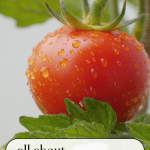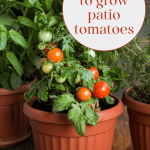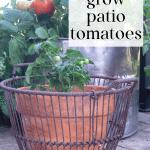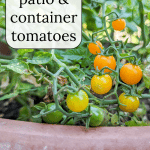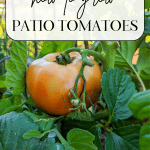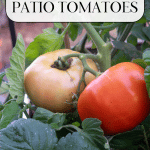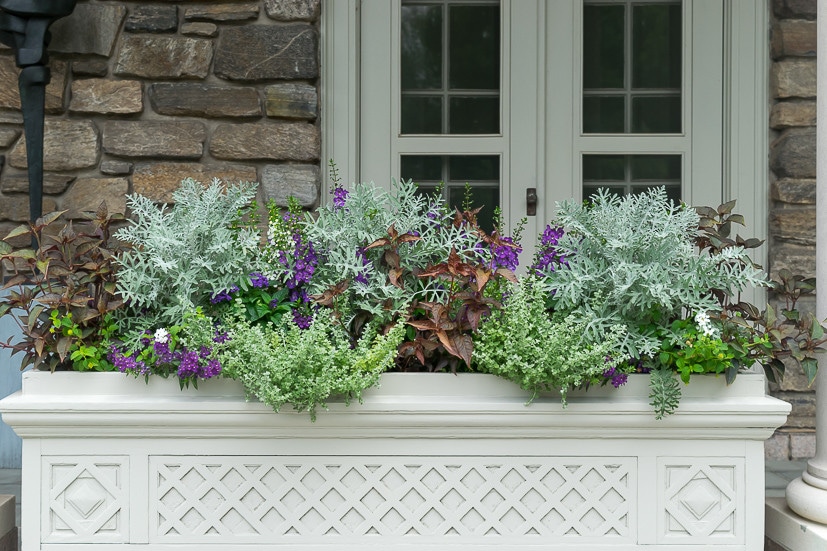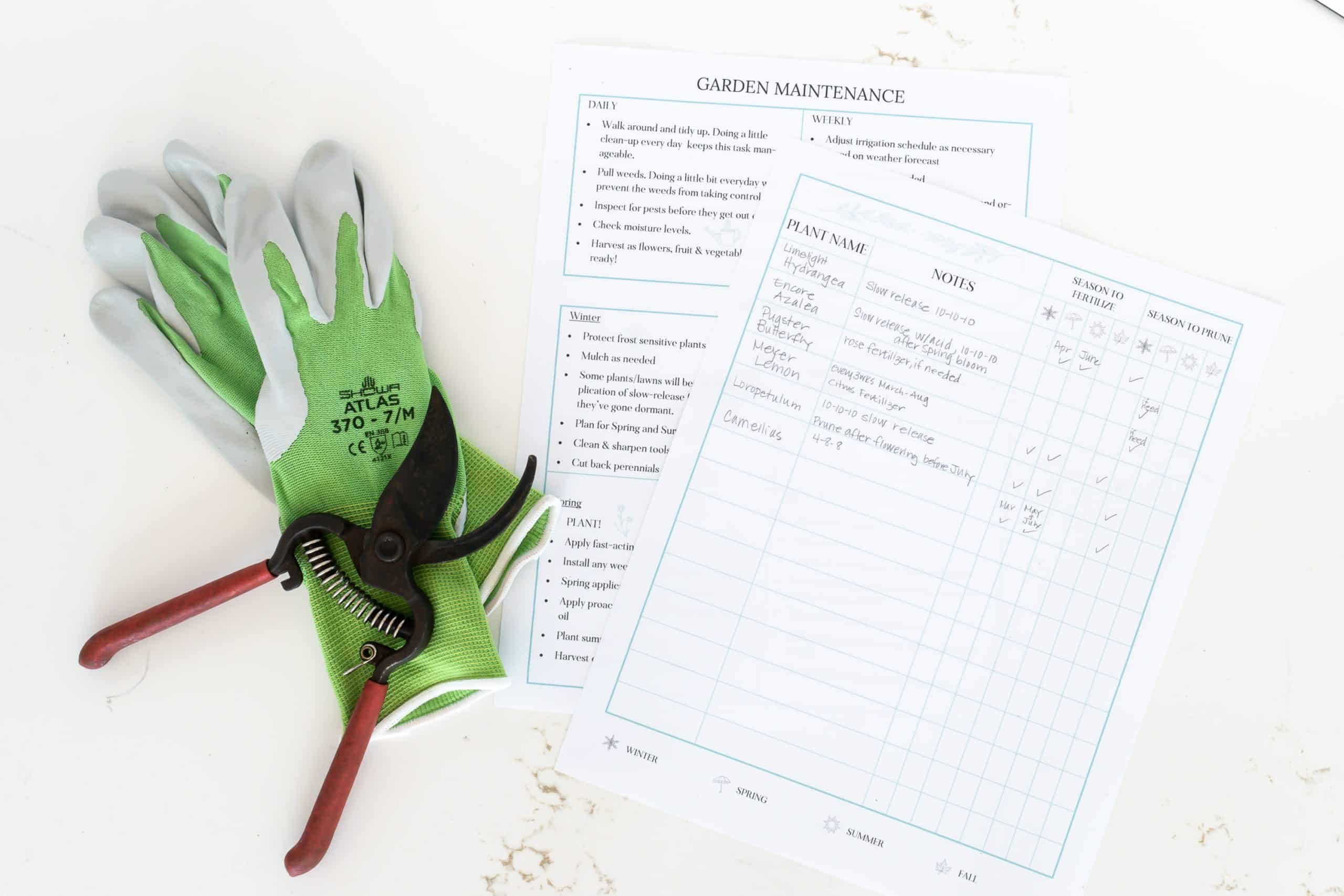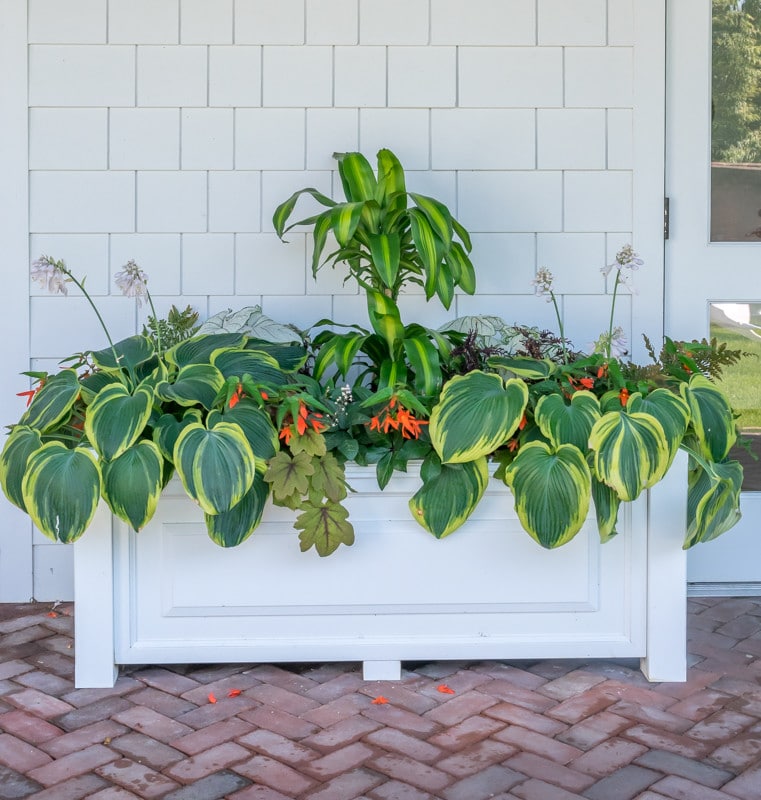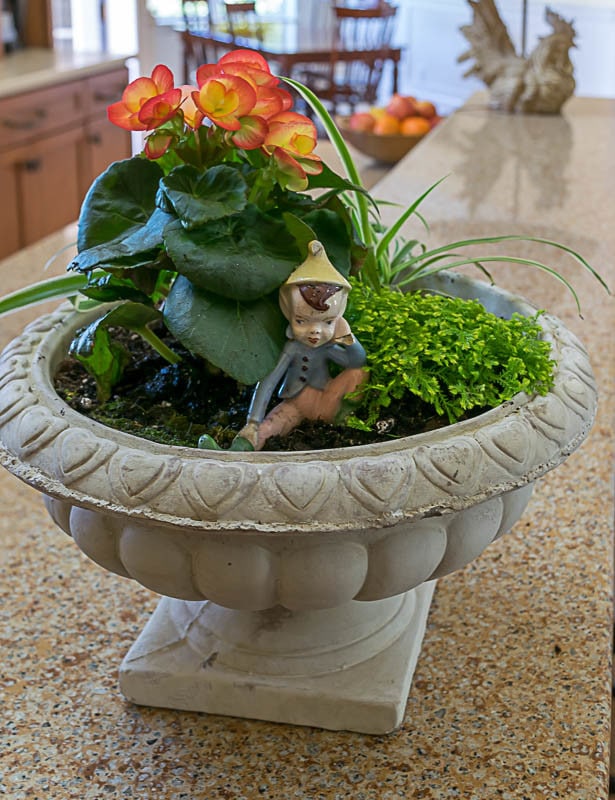Patio Tomatoes: What & How to Grow
Patio tomatoes are the ideal option for those who want tomatoes with that fresh from the garden taste but don’t have the room or desire for a full-blown garden. Let’s look at some of the best container varieties of tomatoes.
There are many variations of the tomato plant perfect for small-space growing. Plus, it has proven to be one of the best small plants for inexperienced home gardeners to start their growing journey!

Table of Contents
Come late summer and early fall; you’ll be loaded with small, juicy, delicious tomatoes to top your burger, salad, or sandwich. Imagine that- Biting into a savory burger dressed with your juicy home-grown fresh tomatoes- YUM!
And the culinary adventures won’t stop there. You’ll have plenty of tomatoes to make the most flavorful salsa, stuffed tomatoes, bruschetta, or garden-grown tomato soup.
There are so many patio tomato plants to choose from—each bringing its unique flair and zest to the table.
Some of these links may be Amazon affiliate links and I may earn a small commission from the sale of these products to help defray the costs of operating this site, but the price you are charged is not affected. You can see my full disclosure policy here.
Determinate or Indeterminate?
I like to have a mix of determinate and indeterminate tomatoes.
- Determinate Tomatoes (D) grow to their full height (3-4 feet) and set their fruit in 4-6 weeks. After that short growing season, they stop producing fruit and slowly begin to weaken, making them more susceptible to disease. Bush tomatoes are typically determinate, making them great for porches and patios as they don’t get as big as indeterminate tomatoes. I like to have determinates as they usually produce fruit earlier, and I’m always anxious to get my first garden-grown tomato…ASAP! Be mindful when planting your determinates that you won’t be on vacation or otherwise unavailable when they are supposed to mature.
- Indeterminate Tomatoes (I), on the other hand, grow all season long and are often labeled vining tomatoes. As vining tomatoes, they will most likely need to be staked and pruned throughout their growing season. While we try to keep our indeterminates pruned to a manageable size, we have had them grow to 7 – 8 feet. Unlike determinates, which produce quickly and all at once, indeterminates will continue to produce fruit slowly and steadily until frost, so they need regular fertilizing to help them grow.
Ten of the Best Tomatoes to Grow on your Patio or in a Container:
- Bush Goliath (D)– For large (3-4″), tasty tomatoes that rival anything you can grow in a full-sized garden, this is your guy. One caveat: unless you do some heavy trimming at the outset, you will need to use a tomato cage or stake this fast grower, which can reach a height of 3 feet.
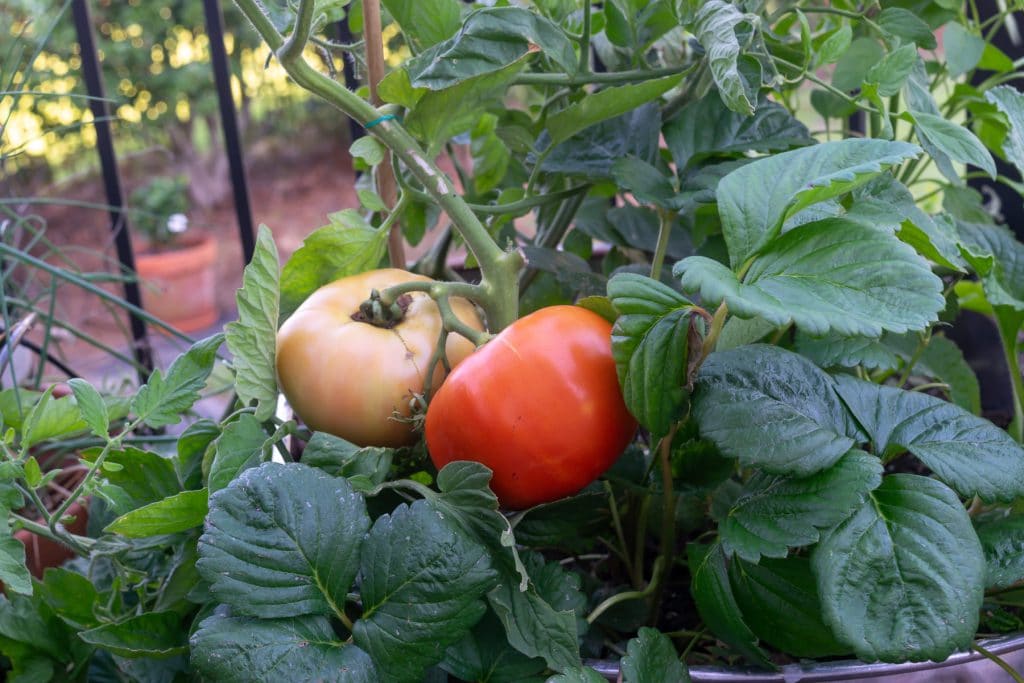
- On the opposite end of the size spectrum is the tiny Currant Tomato (I), so named because the fruit is the size of a currant. The two varieties I am aware of are the Gold Rush and the Sweet Pea. I purchased the Gold Rush at the Philadelphia Garden Show, which is growing beautifully in my Southeastern North Carolina patio garden. I bought it specifically for its draping characteristic; I thought it’d be great in my edible container garden. But, this tomato can also be planted in the garden and staked.
- The Tiny Tim Tomato (D) is a compact plant that will produce 3/4″ red cherry tomatoes in a window sill garden or small pots. The mature plant will grow to be about 18″ tall and as wide as the container allows.
- Another one of my favorites is the Little Bing Cherry Tomato (D). This bush tomato will reach 18-24″ in height, making it perfect for small spaces. The fruit of the Little Bing is about 1″ in diameter.
- The Yellow Canary Tomato (D) produces yellow fruits about 1 inch in diameter. It is a dwarf variety that can be grown in pots as small as 7 inches, so it is perfect for a small space. It also tolerates lower light levels, so it is an excellent choice if your patio or balcony doesn’t get as much sun as you would like.
- The Red Robin (D) is a super dwarf that produces tomatoes approximately 1¼ inches. The mature plant measures about 1 foot in height and produces mild-tasting fruit. This plant only needs an 8-inch pot, will produce a bounty of fruit, and is also suited for areas with limited space, hanging pots, and growing indoors.
- Elfin (D) produces grape-shaped fruits approximately 1½ inches in length. The Elfin tomato is crisp and delicious. The mature plant should top out at 3′ tall.
- Sprite (D) tomatoes are oval-shaped fruits approximately 1 inch in length, thin-skinned, deliciously sweet, and great to eat on their own. The 3′ tall plant produces a high yield that starts at maturation and continues until the first frost.
- On the tall side (5′ tall), the Red Torch Tomato (I) produces oblong, lightly striped tomatoes measuring 1 1/2″ long. Despite its height, this tomato performs well in small gardens and containers.
- The prolific and aptly named Patio Hybrid Tomato (D) will top out at 2 feet tall but still produce a bounty (up to 50 tomatoes over two months) of quite good-sized tomatoes weighing 3-4 ounces. They do have solid stems but may still benefit from staking.
What Do You Need for Thriving Patio Tomato Plants?
You’ll need all the essential equipment for growing any potted plant. For your patio tomatoes, be sure to have the following materials handy:
- Medium to large container or pot with draining holes
- Tomato seeds or tomato seedlings
- Balanced fertilizer or another alternative
- A good loamy soil.
- Compost (optional but helpful!)
- Soil moisture and pH meter (optional but helpful)
- Watering can
- Sunny outdoor location (they’ll need that full sun goodness!)
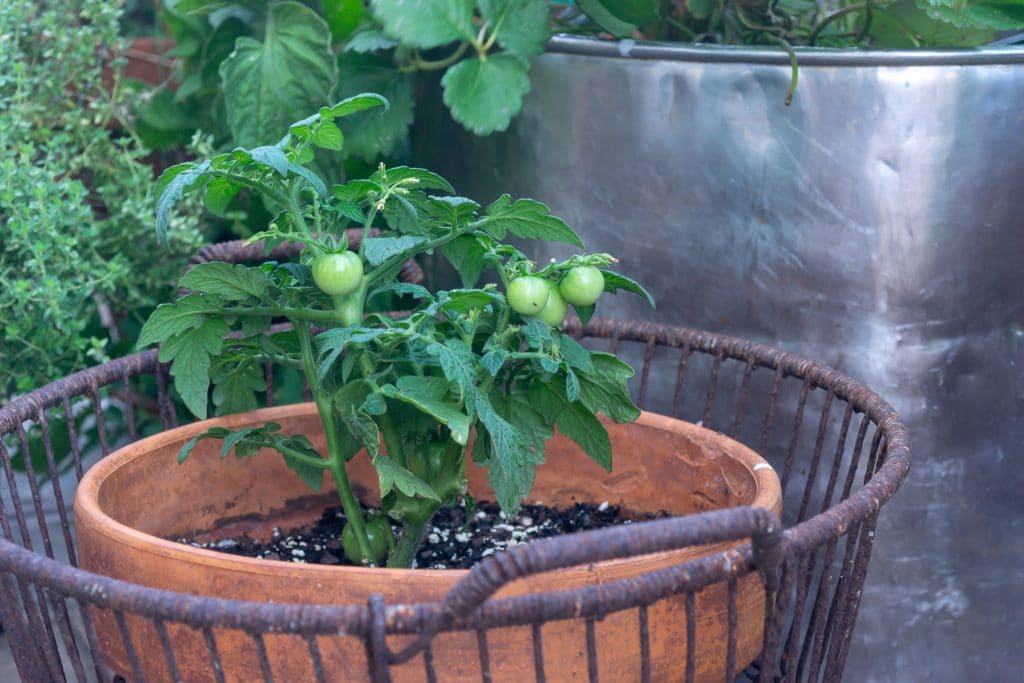
How to Grow Patio Tomatoes at Home
Easy to grow and delightful to eat, you’ll have an incredible summer of watching your potted patio tomato come to life and cooking up some fresh and flavorful meals within weeks.
Choose the Right Pot
Pot size matters! Be sure your container is large enough for your tomato plant. Yes, the varieties you will use may be smaller than tomatoes grown on the ground. But they still need plenty of space to spread their roots. It’s best to pick a pot or container of medium to large size with suitable drainage holes. Excess water can cause fungal diseases and more.
- Look for a pot at least 18″ in diameter for determinate tomatoes.
- You’ll need a pot with at least a 24″ diameter for indeterminate tomatoes.
Pro Tip: Unless the pot is huge, have just one tomato plant in each container to avoid overcrowding.
Pro Tip: Take a look at my guide on Tricks to Fill a Large Planter.
Start at the Right Time
Patio tomatoes need lots of sunlight and will grow best in late spring to early fall. So, plant your seeds in April for a July to September harvest of your container tomatoes.
However, if you get a later start on your patio tomato project, you’ll want to purchase seedlings in small pots from your local garden centers rather than seeds. That way, you can get a head start and plant them by the end of May or early June.

Choosing Your Soil
Like many patio-grown plants and container gardens, your lovely red fruit tomatoes will need lots of nutrients to grow healthy and strong. Choose lightweight, well-draining, nutrient-filled potting garden soil rich in phosphorus and potassium and with a Ph range of 5.5 – 7.5. Some soil suggestions are Black Gold All Organic Potting Soil, Miracle Grow Potting Mix, and Espoma Organic Potting Mix.
Pro Tip: If I use regular, run-of-the-mill potting soil without compost, I will always add compost from our pile to the ground for my tomatoes and other vegetables.
Pro Tip: I also add pulverized eggshells to my soil for the added calcium, which helps prevent blossom end rot.
Find the Perfect Home for Your Patio Tomato Plant |
Tomatoes need bright sunlight, whether grown in your garden or on your patio. Avoid locating your plant under any shade, like a large tree or under your patio roof.
These little tomato plants require about 6 to 8 hours of direct sunlight. But, what’s great about potted plants is you can move them around your patio or yard throughout the day to ensure it soaks up all the sunshine it needs.
Pro Tip: Don’t guess about sun exposure. Watch the areas you are considering before placing the plant there. The best way to do this is to observe the possible locations for a few days and record how many hours of sun they are getting. Then, you can decide where your patio tomato will live as it grows tall and strong.
Watering Your Potted Tomato Plant |
Providing your growing tomatoes with the proper water will be critical to a successful harvest. If the soil is too dry, the plant will undergo stress. In contrast, too much water can cause root rot. After all that work, you sure don’t want that.
Especially in warmer climates, your patio tomatoes will likely need to be watered daily. However, an excellent way to determine if your plant is thirsty is to push your finger into the soil about 2 inches deep. If the soil feels dry, it’s time to water your container plants.
Pro Tip: You may want to invest in an inexpensive soil meter for the best results. This innovative tool will tell you if you need to grab the watering can. Plus, many soil meters will also measure sun exposure and soil PH.
Fertilizing Your Tomatoes |
Feeding your tomatoes is another component of optimal patio tomato care. Fertilize your tomatoes when planted, and then apply a small amount of granular tomato fertilizer about every two or three weeks or per the specific instructions. Once the flowers are set, make sure your fertilizer is higher in Potassium (the K in N-P-K) than Nitrogen or Phosphorous.
Several times over the summer, we will also use compost tea to help support the soil and the organisms it holds.
Remember, with any gardening, balance is critical. Too much or too little fertilizer can make or break the production level of your patio tomatoes, as will inconsistent watering.
Don’t Forget to Prune Your Plants |
To get the highest amount of fruit from your developing patio tomato plant, pinch the suckers and cut the damaged branches below the bottom-most branch that has fruit on it. This will improve airflow and reduce opportunities for disease.
Maintaining Your Patio Tomato Plants
Here are a few more maintenance tips for caring for your precious tomato plants.
Disease and Pests– Most patio tomato varieties are disease-resistant. If you see any discoloration of the leaves, pick them off immediately. Just because your tomatoes are on your deck or your porch doesn’t mean they are safe from the pests that typically damage your plants and eat your fruit. Birds will have no problem flying onto your patio to peck away at that beautiful red tomato you just wanted to let have one more day in the sun! It pains me, but we often pick them a day or two before I want to because I swear the birds are waiting for them to be perfect.
And those nasty tomato hornworms. They will find their way onto your patio tomatoes without a problem. I usually pick them off and stomp on them, but if you are too squeamish, consider using an organic caterpillar killer spray. This is what we use.
But be warned: The BT in the caterpillar killer takes at least 48 hours and up to 2 weeks to work. By then, your tomato crop will be decimated. Honestly, just put on gloves, pull the nasties off, and stomp on them!
Freezing Temperatures- Bring your plants indoors for colder nights and freezing temperatures, especially in early development. Tomatoes are not fond of frost and freezing temperatures. But, when your patio tomatoes begin to produce fruit, you can harvest the green tomatoes early and bring them indoors. Wrap them up in newspaper and let them ripen in an area not exposed to sunlight.
Time to Harvest!
When your beautiful patio tomatoes become firm and fully colored, it’s time for picking!
Remember to harvest your ripe tomatoes as soon as they’re ready in warmer climates. Otherwise, they will quickly overripen and become soft.
Check on your tomatoes daily and bring the fully developed fruits inside to prevent this.
Pro Tip: Did you know that a single patio tomato plant can produce as many as 50 tomatoes in just a few weeks? This means you can look forward to enjoying plenty of delicious tomato dishes by the end of summer and into early fall. If you’re growing more than one patio tomato plant, you can even plan on sharing your harvest with friends and neighbors.
What to do with all of your Homegrown Patio Tomatoes:
Need ideas on ways to use the bounty from your patio tomato plants? Here are some of my favorite tomato recipes.
Bookmark this page or pin the following image to refer back to this post on growing patio tomatoes in the future.
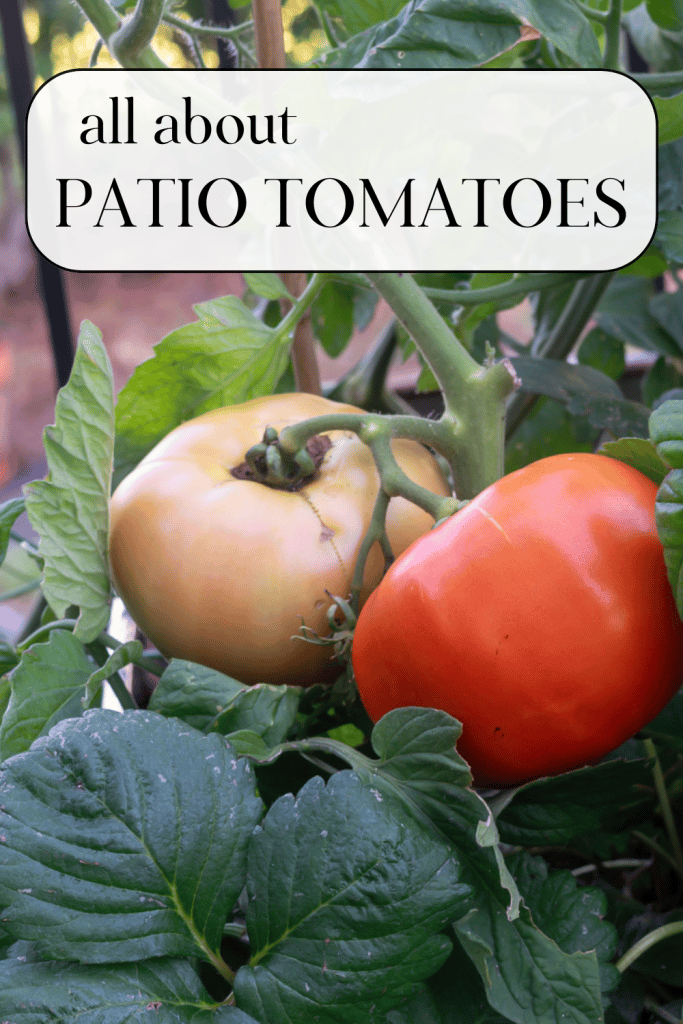
Thanks so much for spending a few minutes of your busy day with me!
To ensure you don’t miss future content, pop your email in the pale green box on the right or click here. I usually send one email weekly, so I won’t inundate your inbox. I’m sensitive to an overflowing email inbox!
We will only use your email address to send you emails, no more than 1-2 weekly. In addition, you will have access to my growing library of knit & crochet patterns and other printables. Check back often as this library will continue to grow. You can unsubscribe anytime by emailing me or clicking on the “unsubscribe” link at the bottom of all emails.
And you can access many of the products I refer to on my Nourish and Nestle Amazon Page. You can access it here.
So, if you’d like to participate in the ‘subscriber benefit’ action, simply subscribe to Nourish and Nestle here or use the form on the right sidebar. It’s slightly towards the top.
I have sent all my subscribers the link to the Subscriber Benefits Library. If you missed it or misplaced it, let me know.
Until next time…


